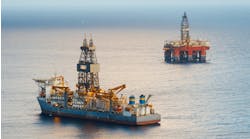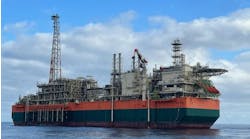Offshore staff
LONDON/HOUSTON/SINGAPORE — Global deepwater production should climb to 17 MMboe/d by 2030, according to Wood Mackenzie, a Verisk business.
The consultant’s "Global deepwater 2022 state of the industry" report expects the sector to account for 8% of the world’s upstream oil and gas supply by the end of this decade, up from 6% currently.
Marcelo de Assis, director of upstream research, cited Brazil, Guyana and Mozambique as the main sources of the growth, adding that “developments are also getting deeper; production from water depths of over 1,500 m will surpass that from 400 to 1,500 m by 2024."
At the same time, traditional growth regions such as the US Gulf of Mexico and Angola have not been delivering major new commercial finds.
The outlook for mature deepwater basins remains uncertain, de Assis cautioned.
“We could see production performance begin to peak and then plateau after 2030 without an exploration and investment renaissance," he said. “However, the characteristics of deepwater makes it an attractive hunting ground for those seeking advantaged resources. Deepwater economics and emissions intensity metrics are among the best in the industry.
“Companies focused on the most resilient projects and decarbonization will continue to consider the sector as core to their upstream business models.”
A major challenge for the industry is cost inflation. Constraints in the global deepwater supply chain will increase lead times and unit costs, he warned, with efficiency gains made during previous downturns beginning to reverse.
Wood Mackenzie expects deepwater production (in water depths above 400 m) to reach 10.4 MMboe/d this year.
Brazil remains the leading deepwater producer, delivering about 30% of current global capacity and growing. Guyana will produce 1 MMboe/d within the next five years, and 14 other countries will contribute to the deepwater supply mix in the coming years.
However, control over major deepwater projects remains in the hands of relatively few companies, with eight accounting for 65% of deepwater production and 67% of the remaining project value.
Petrobras and the seven majors operate 22 of the top 25 deepwater assets, with Petrobras’ deepwater portfolio around twice the size of the number two, Shell. Exxon Mobil and TotalEnergies should deliver the highest growth rates in the sector this decade.
Wells in the most prolific deepwater basins typically recover huge volumes of oil and gas from each well, with strong economic returns and low Scope 1 and 2 emissions intensities relative to most other oil and gas resource theaters, the report pointed out.
At the same time, the majors are intent on cutting their deepwater emissions by reducing flaring and methane leaks, optimizing platform operations and adding electrification, where possible.
As for the pre-FID project pipeline, there are widespread opportunities, with average investment returns in Wood Mackenzie’s global database of deepwater development projects of 24%, at $60/bbl Brent.
Best returns are associated with smaller oil fields that can be tied back to nearby infrastructure, with the lowest from gas supply projects with long lead times.
But as activity levels grow, equipment and services availability will act as a constraint, along with higher commodity prices. In some regions, the report found, deepwater rig costs have doubled compared to 2021 day rates, with the US GoM and Brazil hit hardest.
Shell’s Gato do Mato in the Brazilian presalt could be delayed by up to two years due to rising costs.
12.01.2022





